Lockheed Martin KC-130
| KC-130 Hercules | |
|---|---|
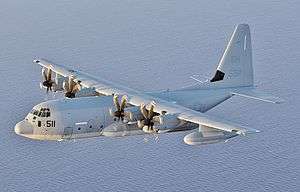 | |
| A KC-130J from VMGR-252 flies over Mediterranean Sea, June 15, 2014 | |
| Role | Tanker (aircraft) / Transport, Overwatch / Ground support ((Harvest HAWK variant)). |
| National origin | United States |
| Manufacturer | Lockheed Lockheed Martin |
| Introduction | KC-130F: 1962 KC-130R: 1976 KC-130T: 1983 KC-130J: April 2004 |
| Retired | KC-130F (2006) KC-130R (2007) |
| Status | Active |
| Primary users | United States Marine Corps Royal Canadian Air Force |
| Number built | KC-130B: 6 KC-130F: 46 KC-130H: 33 KC-130R: 14 KC-130T: 28 KC-130J: 42 |
| Unit cost | |
| Developed from | Lockheed C-130 Hercules Lockheed Martin C-130J Super Hercules |
| Developed into | Lockheed Martin HC-130J[3] Lockheed Martin MC-130J[3] |
The Lockheed Martin KC-130 is the basic designation for a family of the extended-range tanker version of the C-130 Hercules transport aircraft modified for aerial refueling. The KC-130J is the latest variant operated by the United States Marine Corps, with 48 delivered out of 79 ordered. It replaced older KC-130F, KC-130R, and KC-130T variants, while one USMC reserve unit still operates 12 KC-130T aircraft.
Development
The KC-130F made its first test flight in January 1960 as the GV-1 under the old Navy designation system. First entering service in 1962, the KC-130F was designed to undertake aerial refueling missions in support of USMC aircraft. It was developed from the Lockheed C-130 Hercules.
The newest Hercules, the KC-130J, shares 55 percent of the same airframe as preceding models, but in fact is a greatly improved airplane. It is based on the Lockheed Martin C-130J Super Hercules and provides significant increases in operational capability and performance margins over preceding KC-130F/R/T (legacy) aircraft. Additionally, The KC-130J reduces cost of ownership through system reliability and reduced maintenance man-hours per flight hour.
The new HC-130J combat rescue tanker and MC-130J special operations tanker are both derived from a KC-130J baseline.[3]
Technological development has led to the incorporation of interior/exterior night vision lighting, night vision goggle head-up displays, global positioning system, and jam-resistant radios. Some KC-130s are also equipped with defensive electronic and infrared countermeasures systems.
Design
_receive_fuel_from_a_KC-130_Hercules.jpg)
The KC-130 is a multi-role, multi-mission tactical tanker/transport which provides the refueling support required by the USMC for its aircraft. This versatile asset provides in-flight refueling to both tactical aircraft and helicopters within a 500-nautical-mile (930 km) operating radius, as well as rapid ground refueling when required. Additional tasks performed are aerial delivery of troops and cargo, emergency resupply into unimproved landing zones within the objective or battle area, emergency medical evacuation, tactical insertion of combat troops and equipment, and evacuation missions.
KC-130J
The KC-130J offers a 60,000 pound fuel capacity that it can allocate between its own flight requirements against aerial refueling offload capacity using its wing and external tanks while in the air. When more fuel is needed, an additional 24,392 pounds of fuel can be offloaded from a specially configured internal fuselage 3,600-gallon aluminum fuel tank. The system also functions without the fuselage tank, so the cargo compartment can be used for cargo on the same mission, giving the aircraft even greater flexibility.
The aircraft is ready to fuel fixed-wing, tilt-rotor, or rotary-wing aircraft using the standard probe and drogue technique. The two wing-mounted hose and drogue refueling pods (made by Sargent Fletcher) can each transfer up to 300 gallons per minute to two aircraft simultaneously allowing for rapid cycle times of multiple-receiver aircraft formations (a typical tanker formation of four aircraft in less than 30 minutes).
The KC-130J also provides for rapid ground refueling of helicopters, vehicles and fuel caches. The aircraft has a unique propeller feathering feature (known as “hotel mode”, derived from the term hotel electric power, when a vessel or other means of transport is equipped with a power plant with the sole purpose of generating electric power for lighting, etc., rather than propulsion) which can slow (at 25% rotation speed) the propellers while the turbines continue to run and energize the generator, providing power to the electric fuel pumps. This reduction of the propellers' speed helps to eliminate prop wash behind the KC-130J. This allows ground forces to operate in relative calm while the aircraft offloads up to 600 gallons (4,018 pounds) per minute.
The U.S. Marine Corps has chosen the KC-130J to replace its aging KC-130 legacy tanker fleet. The new KC-130J offers increased utility and much needed improvement in mission performance. As a force multiplier, the J-model tanker is capable of refueling both fixed- and rotary-wing aircraft as well as conducting rapid ground refueling. The refueling speed envelope has been widened from 100 to 270 knots (500 km/h) indicated airspeed, offering more capability and flexibility.[4] Offload rates per refueling pod can be up to 300 gallons per minute simultaneously. The KC-130's offload is significantly greater than previous Hercules tankers. As an example, at 1,000 nautical miles (1,852 km), the fuel offload is well over 45,000 pounds (20,412 kg).
Harvest HAWK
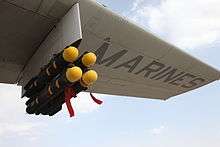
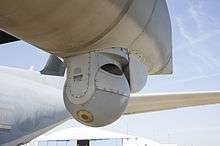
With the addition of the Marine Corps's ISR / Weapon Mission Kit, the KC-130J will be able to serve as an overwatch aircraft and can deliver ground support fire in the form of Hellfire or Griffin missiles, precision-guided bombs, and eventually 30mm cannon fire in a later upgrade.[5] This capability, designated as "Harvest HAWK" (Hercules Airborne Weapons Kit), can be used in scenarios where precision is not a requisite, such as area denial.[6]
The AN/AAQ-30 Target Sight System (TSS) integrates an infrared and television camera, and is mounted under the left wing's external fuel tank. It is the same TSS used on the upgraded AH-1Z Viper attack helicopter .[7] The typical loadout is four Hellfire missiles and 10 Griffin GPS guided missiles.[8] The weapons systems operator uses a Fire Control Console mounted on an HCU-6/E pallet in the KC-130J’s cargo compartment.[9]
The aircraft retains its original capabilities in refueling and transportation. The entire system can be removed in less than a day if necessary.[10] The USAF MC-130W Dragon Spear program uses a similar concept.
The USMC plans to acquire three kits per active-duty KC-130J squadron for a total of nine kits, each costing up to US$22 million.[11] It was first test flown on 29 August 2009 by VX-20, and first deployed in October 2010 with VMGR-352.[10]
Operational history
The KC-130 has supported operations in the Vietnam War,the Falklands War for Argentina, Operation Desert Shield, Operation Desert Storm, Operation Enduring Freedom, Operation Iraqi Freedom and other USMC operations over the last fifty years.
VMGR-252, Cherry Point, NC, was the first fleet squadron to transition to the KC-130J. Contrary to most military squadrons when they transition to a new aircraft, VMGR-252 did not "stand down" to train and equip for the new airframe. Quite the contrary, they continued full-time fleet support with their "legacy" Hercs until fully converted to the J model. This trend was continued by squadrons as they transitioned to the KC-130J.
In February 2005, VMGR-252 made the first operational combat deployment of the KC-130J when six aircraft were deployed to Al Asad, Iraq in support of Operation Iraqi Freedom. During this time VMGR-252 experienced many "firsts" with the new J model conducting aerial refueling, delivery of cargo and passengers, the first combat aerial delivery of supplies by any J model user (the USAF subsequently conducted aerial delivery in Afghanistan with their new J models later that year) and battlefield illumination. VMGR-252 maintained the sole KC-130J presence for a year while VMGR-352 took delivery of and transitioned to the J model. The semi-permissive threat environment and the state of the art defensive systems of the J model permitted it to operate over the battlefield, providing fuel for the jets close to the fight, versus the tanker being far behind the lines in relative sanctuary. On more than one occasion VMGR-252 aircraft came under fire from insurgents, as did VMGR-352 aircraft during subsequent deployments to Iraq.
In 2006, VMGR-252 and 352 shared a joint detachment in Iraq and this paradigm continued for a number of years. In the summer of 2006, VMGR-252 provided a two KC-130J detachment in support of the 24th Marine Expeditionary Unit (24MEU) to RAF Akrotiri in Cyprus during the Lebanon/Israeli conflict that summer. Also during this time VMGR-252 began extensive operational training and tactics development with the new MV-22 Osprey, refining long range tanker procedures with the new tilt-rotor aircraft.
In Spring 2008, VMGR-252 again made KC-130J history by providing the KC-130J aircraft detachment to 24MEU as they reestablished the USMC presence in Kandahar, Afghanistan. This deployment experienced numerous great KC-130J successes conducting all manner of expeditionary type missions routinely landing at austere dirt runways, tactical aerial delivery of goods, and the traditional logistic support and refueling missions that are the hallmark of USMC KC-130 support.
Though the USMC KC-130Js have left Iraq, a continuing KC-130J presence has now been maintained in support of Operation Enduring Freedom in Afghanistan, with aircraft and crews provided by both VMGR-252 and 352 during different periods. In May 2009, the Okinawa-based "SUMOS" of VMGR-152 provided two aircraft and crews to support the OEF presence. This was VMGR-152's first operational combat deployment since Vietnam, and they have been maintaining a continuing presence in Afghanistan with VMGR-352/252.
USMC KC-130J aircraft from VMGR-252 and 352 have additionally been deployed to Djibouti for operations in the Horn of African supporting counter-terrorist operations in the region.
After the 2010 Pakistan floods, KC-130Js from USMC VMGR-352 squadron delivered over 200,000 pounds of cargo across Pakistan in support of flood relief efforts.[12]
The Harvest Hawk weapons system for USMC KC-130J aircraft began its first deployment during October 2010 in Afghanistan with Marine Aerial Refueler Transport Squadron 352 (VMGR-352).[10] Its first weapons engagement was on 4 November supporting the 3rd Battalion 5th Marines in Sangin. One Hellfire missile was fired and five enemy insurgents were killed. The battle damage assessment stated there were no civilian casualties or property damage during the fire fight.[8]
A KC-130J from the 26th MEU participated in a pilot rescue during Operation Odyssey Dawn.[13]
Variants
- KC-130B
- Six C-130B models were modified into in-flight refueling tankers. 4 currently operating with the Republic of Singapore Air Force (all four to be upgraded to KC-130H standard), 2 with Indonesian Air Force.
- KC-130F
- Enhanced KC-130B, 46 built
- KC-130H
- Tanker variant of C-130H, 33 built
- KC-130R
- 14 former USAF aircraft transferred to the U.S. Marine Corps.
- KC-130T
- Variant from C-130H, 28 built
- KC-130T-30
- Variant from C-130H-30, 2 built (source: http://www.airliners.net/photo/USA---Marines/Lockheed-KC-130T-30-Hercules/2166650/&sid=5951c5eac7ad46d6efdc40139e1a0cc4). These have been transferred to the U.S. Navy and converted to C-130T-30s.
- KC-130J
- Variant from C-130J
Operators
_352%2C_stagger_themselves_during_a_refueling_training_exercise_off_the_coast_of_Southern_California.jpg)
- Argentine Air Force
- 1st Air Transport Squadron – El Palomar Air Base KC-130H
- Brazilian Air Force
- 1º/1ºGT (1º Esquadrão do 1º Grupo de Transporte) – Galeão Air Force Base, Two KC-130H
- Royal Canadian Air Force
- 435 Transport and Rescue Squadron operates 5 KC-130H as CC-130H(T)
- French Air Force
- Two KC-130Js on order[14] and delivery in 2016.
- Israeli Air Force
- 103 "Elephants" Squadron at Nevatim KC-130H
- 131 "Yellow Bird" Squadron at Nevatim KC-130H
- Japan bought six KC-130R aircraft that were retired and in storage. They are being refitted with new landing gear supports, cargo door supports, center wing rainbow fittings, and corrosion repair. In addition to structural modifications, the Japanese will receive thirty overhauled T56-A-16 engines and digital cockpit upgrades to include a digital GPS. Regeneration began in November 2012, with completion expected by late 2013. The JMSDF plan to use the aircraft for troop and cargo movement, humanitarian efforts, transport of senior leaders, and medical evacuation.[17]
- Indonesian Air Force
- Skadron Udara 32 operated 2 KC-130B. One crashed in 2015.
- 3 KC-130J in service, with an option to purchase three more[18]
- 7 are on order
- 4 KC-130T in service[19]
- Operates 2 KC-130H aircraft
 Saudi Arabia
Saudi Arabia
- Royal Saudi Air Force
- 32 Sqn based at Prince Sultan Airbase (KC-130H) : 5 KC-130j on order
- Republic of Singapore Air Force
- 122 Squadron operates 4 KC-130B and 1 KC-130H. Upgraded by ST Aerospace with a new glass cockpit, avionics suite, and flight management system which makes the aircraft Global Air-Traffic Management (GATM)-compliant. The KC-130Bs will also receive an auxiliary power unit and environmental control systems in common with C-130Hs.[20][21]
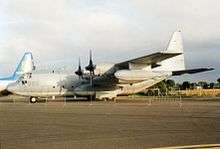
- United States Marine Corps
- United States Navy
- VX-20, a combined USN / USMC squadron, operates 1 KC-130J used for testing and evaluation, and 3 KC-130R for refueling USN and USMC aircraft conducting tests at NAS Patuxent River
- VX-30 operates 3 KC-130F for refueling USN and USMC aircraft conducting tests on the NAVAIR Point Mugu Range; the KC-130Fs also conduct range clearing and safety surveillance
- United States Coast Guard
Specifications (KC-130J)
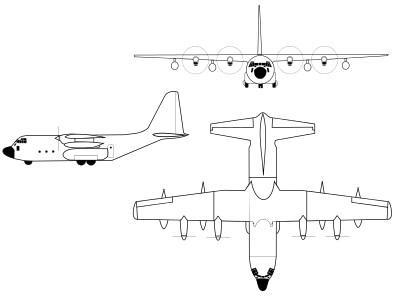
Data from Lockheed Martin KC-130J Super Tanker fact sheet,[22]
General characteristics
- Crew: 4 (two pilots,one crew chief and one loadmaster are minimum crew)
- Capacity: :* 92 passengers or
- 64 airborne troops or
- 6 pallets or
- 74 litter patients with 2 medical personnel
- 2–3 Humvees or an M113 armored personnel carrier
- Payload: 42,000 lb (19,090 kg)
- Length: 97 ft 9 in, 29.79 m (for C-130J-30: 112 ft, 9 in, 34.69 m)
- Wingspan: 132 ft 7 in (40.41 m)
- Height: 38 ft 10 in (11.84 m)
- Wing area: 1,745 ft² (162.1 m²)
- Empty weight: 75,562 lb (34,274 kg)
- Useful load: 72,000 lb (33,000 kg)
- Max. takeoff weight: up to 175,000 lb (79,378 kg); normal 155,000 lb (70,305 kg)
- Powerplant: 4 × Rolls-Royce AE 2100D3 turboprop, 4,637 shp (3,458 kW) each
- Propellers: Dowty R391 6-blade composite propeller, 1 per engine
- Fuel offload capacity: 57,000 lb (26,000 kg)
Performance
- Maximum speed: 362 knots (417 mph, 671 km/h)
- Cruise speed: 348 kn (400 mph, 643 km/h)
- Range: 2,835 nmi (3,262 mi, 5,250 km)
- Service ceiling: 28,000 ft (8,615 m) with 42,000 pounds (19,090 kilograms) payload
- Takeoff distance: 3,127 ft (953 m) at 155,000 lb (70,300 kg) gross weight
See also
- Related development
- Lockheed C-130 Hercules
- Lockheed Martin C-130J Super Hercules
- Lockheed AC-130
- Lockheed DC-130
- Lockheed EC-130
- Lockheed HC-130
- Lockheed LC-130
- Lockheed MC-130
- Lockheed WC-130
- Lockheed L-100 Hercules
- Aircraft of comparable role, configuration and era
- Related lists
- List of Lockheed aircraft
- List of active Canadian military aircraft
- List of active United Kingdom military aircraft
- List of active United States military aircraft
- List of military aircraft of the United States (naval)
- List of aircraft of the Israeli Air Force
- List of aircraft of the Royal Air Force
- List of C-130 Hercules crashes
- List of United States military aerial refueling aircraft
References
- ↑ Sherman, Robert. "KC-130". Federation of American Scientists. Retrieved 10 August 2015.
- ↑ Balle, Joakim Kasper Oestergaard. "About the KC-130J". Aeroweb. Retrieved 5 May 2015.
- 1 2 3 First Lockheed Martin/USAF HC-130J Combat Rescue Tanker Rolls Out | Lockheed Martin Archived 26 April 2010 at the Wayback Machine.
- ↑ John Pike. "KC-130J". Globalsecurity.org. Retrieved 8 May 2012.
- ↑ "General James T. Conway on The Posture of the United States Marine Corps.". zumwaltfacts.info. 14 May 2009. Retrieved 1 August 2010.
- ↑ McCullough, Amy (1 June 2009). "Refuel and Fire". Marine Corps Times.
- ↑ "From Hueys to Harvest Hawk: Ordnance Marine arms aircraft in Afghanistan" by Cpl. Samantha H. Arrington, DVIDS. 19 May 2011
- 1 2 Hurla, Sgt Deanne (16 November 2010). "KC-130J Harvest Hawk takes on new role in Afghanistan". 3rd Marine Aircraft Wing (Fwd) Public Affairs. DVIDS. Retrieved 5 April 2010.
- ↑ "Harvest HAWK completes phase one testing here". Naval Air Systems Command. 26 April 2010.
- 1 2 3 Flurry, SSgt Christopher (1 April 2011). "KC-130J Harvest Hawk: Marine Corps teaches old plane new tricks in Afghanistan". 2nd Marine Aircraft Wing (Fwd). Camp Dwyer, Afghanistan: United States Marine Corps. Retrieved 5 April 2011.
- ↑ O'Quin, Cpl Christopher (11 September 2009). "Harvest Hawk mission kit brings new era in Marine aviation". 3rd Marine Aircraft Wing. United States Marine Corps.
- ↑ States, United. "Marine Corps KC-130 arrives in Pakistan | Flickr – Photo Sharing!". Flickr. Retrieved 8 May 2012.
- ↑ Lamothe, Dan (22 March 2011). "Details of Marines' pilot rescue released". Marine Corps Times. Retrieved 24 March 2011.
- ↑
http://www.avionslegendaires.net/2015/12/actu/larmee-de-lair-operationnelle-super-hercules-2016/
Part of a series on the French language History Grammar Orthography Phonology - Elision
- Liaison
- Aspirated h
- Help:IPA for French
- ↑ "Alenia Aeronautica: flight refuelling tests for the Eurofighter Typhoon with Italian Air Force C-130J tanker successfully completed" (PDF). Alenia Aeronautica. 10 November 2008. Retrieved 5 June 2013.
- ↑ "Crashed Italian C-130J confirmed as modified tanker". Flight International. 24 November 2009. Retrieved 8 May 2012.
- ↑ Sale Gives New Life to Excess C-130s - NAVAIR.Navy.mil, March 7, 2013
- ↑ "Lockheed Martin Awarded Contract for Kuwait Air Force KC-130J Tankers." defpro.com, 27 May 2010. Retrieved 17 July 2010.
- ↑ "Order of Battle - Malaysia".
- ↑ Gary Parsons (21 September 2010). "Singapore gets first upgraded C-130". Key Publishing. Retrieved 28 June 2011.
- ↑ Greg Waldron (12 November 2010). "Singapore's C-130 upgrade makes progress". Flight International. Retrieved 28 June 2011.
- ↑ "Fact sheet: KC-130J Super Tanker" Lockheed Martin, October 2009 Retrieved: 3 October 2010.
External links
| Wikimedia Commons has media related to KC-130 Hercules. |
- "KC-130". GlobalSecurity.org. 15 June 2005. Retrieved 30 June 2011.